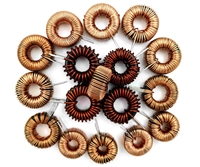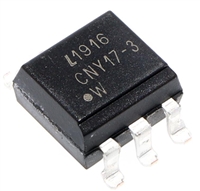AOZ1935
Detailed Description
The AOZ1934/5 is a unique current regulated step-up
(boost) converter. Two (or three for AOZ1935) current
regulating devices are integrated to drive two or three
strings of LEDs. Unused channels need to be connected
to ground (GND).
recover from no current within 1µs. This allows very short
PWM on-time or a duty-cycle with fine resolution.
Assume a 50µs minimum on-time for a 100Hz PWM
signal, a 200:1 ratio can be achieved by PWM.
The minimum PWM on-time of 1μs is required in
AOZ1934/5’s application, this means minimum PWM
duty cycle of 2% for 20kHz dimming frequency and
0.02% for 200Hz dimming frequency. The amplitude of
PWM signal should not be higher than AVCC, otherwise
test mode will be triggered.
The voltage step-up is accomplished by a boost topology,
using an inductor-based DC-DC switching converter, in
which the inductor serves as an energy storage device in
the system. By integrating a high voltage optimized
MOSFET, the AOZ1934/5 internal switching frequency is
800kHz while still maintaining high power efficiency.
Unlike a traditional DC-DC boost converter with a fixed
output voltage, the AOZ1934/5 dynamically changes its
output voltage regulation parameters depending on the
load. The use of unique control schemes maintains
accurate current regulation in each current sink while
leaving the output voltage at a minimum, increasing the
overall conversion efficiency. The internal step-up
converter dynamically controls the voltage at the output
high enough to drive the LED string with the highest total
forward voltage. The wide input voltage range, from 2.7V
to 25V, allows maximum system flexibility; battery
powered devices using 1-, 2-, 3- or 4-cell Li Ion packs
can share the same power architecture. A low power
2.7V to 5.5V input to supply the IC bias circuitry is
required at AVCC pin.
Fault Protection (LED Open or Short)
Each current sink is protected against LED short or
open conditions. If an LED short circuit condition
arises, the current sink continues to regulate until
V
> V
(6V). When any sink node voltage goes
SINK
SOV
above V
for more than 80ms (while PWM dimming
SOV
signal remains high), that channel’s current sink will be
turned off, and other channels will still work if they don’t
trigger this fault condition. For example, if one or more
LEDs on a channel are shorted, that channel’s sink
voltage will increase. If the voltage goes above 6V for
more than 80ms, the Current Sink Fault Protection will be
triggered and only this faulty string will be disabled by
shutting off this current sink. All other channels will
continue normal operation if they don’t have a fault
condition. When PWM dimming control is used, the 80ms
fault delay is accumulated only when PWM signal is high;
the PWM low time is not counted into the fault delay, so
LED brightness control is based on the popular PWM
dimming scheme via the PWM pin. The EN pin provides
ON/OFF control of the IC. By asserting a logic high on
the EN pin, the converter is enabled and will regulate
each of the current sinks at the factory programmed
current setting.
the delay time will be 80ms / D
cycle of the PWM signal).
(D
is the duty
PWM
PWM
In case of an LED failing open, the current sink voltage of
the failed string will go close to ground and dominate the
boost converter control loop. As a result the output
voltage will move up to the over-voltage threshold, set
internally to 40V or by the external resistor divider,
whichever is lower. Once the over-voltage incident is
flagged internally, the faulty channel(s) will be disabled.
Then the output voltage of the boost converter will go
back to normal level. During the entire process, the rest
of the LED strings (healthy LED strings) would continue
normal operation.
Application Information
Power Up Sequence
It’s recommended to power up Vin, AVCC, and PWM
dimming in sequence, and EN pin needs to ramp up
simultaneously or later than AVCC, in order to avoid
latch-off, or mis-operation of device. We do not assume
any liability or responsibility for any loss or damage
arising from misuse or inappropriate use of the product.
The fault conditions are reset when the IC is powered
down and up again.
Current Dimming Using PWM Pin
AOZ1934/5 allows maximum flexibility with a PWM signal
control input which can be used for dimming. The IC
must remain Enabled at EN pin during PWM dimming,
which means the step-up converter is active to reduce
the response time. Combining this with the fast response
of the step-up converter, each LED channel can typically
Output Over-Voltage Protection (OVP)
AOZ1934/5 has built in over-voltage protection function
with 40V threshold at VOUT pin. This level is suitable for
applications with ten series LEDs per string. However, for
applications with fewer series LEDs, the user can choose
Rev. 1.0 August 2010
www.aosmd.com
Page 11 of 14










 压敏电阻器在直流电路中的过压保护应用探讨
压敏电阻器在直流电路中的过压保护应用探讨

 电感耐压值及其与电感大小的关系
电感耐压值及其与电感大小的关系

 CNY17F光耦合器:特性、应用、封装、引脚功能及替换型号解析
CNY17F光耦合器:特性、应用、封装、引脚功能及替换型号解析

 DS1307资料解析:特性、引脚说明、替代推荐
DS1307资料解析:特性、引脚说明、替代推荐
